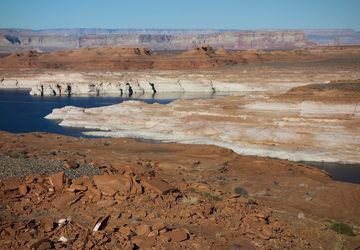Today, the Bill Lane Center for the American West released its Future of Federalism and Foreign Policy Report, made possible by a grant from the California 100 Initiative. For several months, the research team led by Bruce Cain has examined where California has been, where it’s at and where it’s headed when it comes to possible scenarios and policy alternatives for the future.
"Our report takes up the management of certain resources like water and electricity, which are critical assets in California that are threatened by climate change," said Bruce Cain, head researcher for the project. "A balance must be struck between state and local control and public and private control of these resources. Through examination of water and energy management, we identified key challenges of California’s intergovernmental relations and offered solutions that ensure resilience and reliability of the state’s invaluable natural resources."
Click here to read the Future of Federalism Policy and Scenario Report.
The research proposes four alternative scenarios for the state’s future and provides policy options.
Scenario #1: Separate and Unequal
As greenhouse gases continue to accumulate, extreme weather events such as extended droughts and heat waves, unusually large floods, sea level rise and more intense wildfires proliferate dramatically, but trans-border cooperation does not increase. Control of resilience measures resides primarily with local government officials, as do power purchase decisions and other decarbonization decisions (e.g., infrastructure for zero-emissions vehicles). Differences in city capacity and ideology will result in very uneven implementation in both decarbonization and resilience measures.
The past experience with housing, schooling, health care and air quality policy suggests that community responses to climate change will also vary widely unless action is taken to override local powers. In the past, the state legislature has stepped in to limit these local inequalities with statewide programs and requirements to some degree, but as the costs of dealing with extreme weather soar, local communities retreat to protecting themselves and touting their decarbonization virtue without helping poorer communities.
Scenario #2: A State of Permanent Natural Disaster Emergency
Given the failure so far in the United States, and in many countries, to make a strong enough commitment to decarbonization, extreme weather disasters not only worsen, but as a consequence, put many parts of the U.S. under a state of constant emergency powers. Most states give governors wide executive powers to deal with natural disasters. These powers include the ability to suspend laws and regulations that slow or inhibit an effective emergency response. While these measures clear the way for more action, they tip a precarious state-local balance in California as emergency powers become permanent, opening the door to unchecked abuse and political manipulation along with a loss of individual freedoms. This leads to strong time-of-use control by the system operator on electricity and strict limitation of water use for any outdoor purposes. These actions affect the state’s ability to provide new housing and hence impact its appeal to people and businesses that might have considered relocating to California.
Scenario #3: Parochial Ineffectiveness
Extreme weather in the form of long droughts and more destructive wildfires begins to get peoples’ attention, but climate change is not as devastating as some have predicted. Tomorrow looks a lot like today, and trans-border coordination also remains at the same level as today. Local communities continue to closely guard their land use powers, farmers still retain their water rights and communities increasingly opt for local control over energy purchases by forming Community Choice Aggregators (CCAs). Higher levels of coordination happen only during drought and wildfire emergencies, but languish during calm periods between events. Despite the largest devastation from these events, in between emergencies, California is slow to prepare for the next extreme weather event by failing to build adequate water storage or to prevent the state’s electricity transmission system from igniting new fires.
California’s efforts to achieve decarbonization remain limited if the rest of the western region does not participate to the same degree because out-of-state energy continues to have a high fossil fuel profile. States fight over surface water rights. CCAs create energy coordination problems for the state and regional grid system.
Scenario #4: Nascent Trans-Border Efforts
California moves in the direction of better trans-border collaboration in water and energy, but without the urgency of a dramatic, widely-recognized upturn in extreme weather events. With respect to achieving better sharing of water resources, the state builds on its Integrated Regional Water Management Planning Act that established watershed-scale planning processes and funded collaborative water projects with several rounds of bond measures. Even more significantly, the state takes the final steps towards regulating groundwater, creating a stronger regulatory structure over the Groundwater Sustainability Agencies established in 2017 to prevent the over-drawing of aquifers.
California continues to participate in the Western Interconnection, and other states respond by increasing the build-out of wind and solar resources to tap the California market. The California Independent System Operator increases regional coordination activities from its current 36% of regional load. The Western Governors’ Association (WGA), the Western Interstate Energy Board (WIEB) and the Western Energy Coordinating Council (WECC) all provide guidance, research and information related to energy in the West, including parts of Baja California, Mexico. But none of them have the authoritative power to control the load serving entities in terms of what types of energy they are buying for their power needs, or what sort of steps they take to diminish the problems of wildfire ignitions from transmission and distribution lines.
Since climate change is likely to stress California’s water and energy supplies, the researchers at Stanford’s Bill Lane Center for the American West propose the following policy alternatives for the future:
- Both our water and energy systems will have to develop into more coordinated decentralized forms of adequate supply and reliable delivery
- This will mean more storage, more diversification of water sources and more coordinated exchanges across jurisdictional lines.
- California has made steps in this direction for water with the Integrated Regional Water Management and Groundwater Sustainability laws, but needs to do more.
- Storage and local generation such as rooftop solar and batteries will need to become better integrated into the grid, especially as California becomes more dependent on renewables.
“The challenges of extreme weather spill across jurisdictional boundaries and will test the resource adequacy and resilience of water and energy systems," said Bruce Cain, emphasizing the need for new policy. "California needs to develop more coordinated decentralized governance systems to deal with the climate challenges that lie ahead."
“After months of diligent research by our partners across the state, we are excited to share their findings with the public to kickstart a conversation about the policy options we can take to create an inclusive, equitable and sustainable California,” said Karthick Ramakrishnan, PhD, executive director of California 100. “Our research partners engaged a diverse group of stakeholders in their work and it will take all of them and all of us to take this work and make it actionable today – to influence tomorrow.”
California 100, incubated at the University of California and Stanford University, released today its next three policy and scenario reports focusing on the future of health and wellness, immigrant integration and public safety in the golden state. In July, California 100 announced grants to 18 centers and institutes across California to examine future scenarios with the potential to shape California’s leadership in the coming century, with a focus on 13 priority research areas (listed below). In March, California 100 released its first four policy and scenario reports focused on the future of advanced technology, energy, housing, and transportation.
These research reports were produced as part of California 100’s research stream of work led by Henry E. Brady, PhD, Director of Research for California 100, current professor, and former Dean of the Goldman School of Public Policy.
California 100 announced its diverse and intergenerational Commission in October and its Advisory Council in December. California 100’s core mission is to strengthen California’s ability to collectively solve problems and shape our long-term future—through research, policy innovation, advanced technology, and engagement—by identifying, mobilizing, and supporting champions for innovative and equitable solutions.



